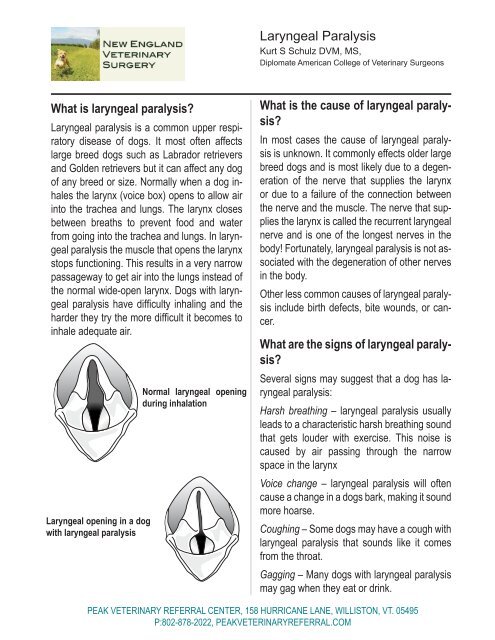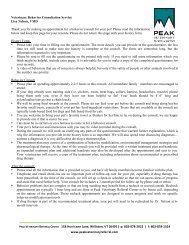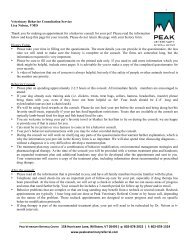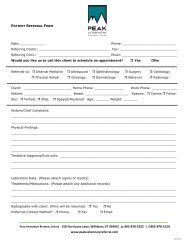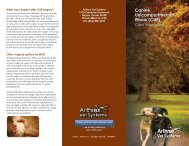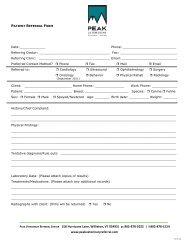Laryngeal Paralysis - Peak Veterinary Referral Center
Laryngeal Paralysis - Peak Veterinary Referral Center
Laryngeal Paralysis - Peak Veterinary Referral Center
Create successful ePaper yourself
Turn your PDF publications into a flip-book with our unique Google optimized e-Paper software.
<strong>Laryngeal</strong> <strong>Paralysis</strong><br />
Kurt S Schulz DVM, MS,<br />
Diplomate American College of <strong>Veterinary</strong> Surgeons<br />
What is laryngeal paralysis<br />
<strong>Laryngeal</strong> paralysis is a common upper respiratory<br />
disease of dogs. It most often affects<br />
large breed dogs such as Labrador retrievers<br />
and Golden retrievers but it can affect any dog<br />
of any breed or size. Normally when a dog inhales<br />
the larynx (voice box) opens to allow air<br />
into the trachea and lungs. The larynx closes<br />
between breaths to prevent food and water<br />
from going into the trachea and lungs. In laryngeal<br />
paralysis the muscle that opens the larynx<br />
stops functioning. This results in a very narrow<br />
passageway to get air into the lungs instead of<br />
the normal wide-open larynx. Dogs with laryngeal<br />
paralysis have difficulty inhaling and the<br />
harder they try the more difficult it becomes to<br />
inhale adequate air.<br />
<strong>Laryngeal</strong> opening in a dog<br />
with laryngeal paralysis<br />
Normal laryngeal opening<br />
during inhalation<br />
What is the cause of laryngeal paralysis<br />
In most cases the cause of laryngeal paralysis<br />
is unknown. It commonly effects older large<br />
breed dogs and is most likely due to a degeneration<br />
of the nerve that supplies the larynx<br />
or due to a failure of the connection between<br />
the nerve and the muscle. The nerve that supplies<br />
the larynx is called the recurrent laryngeal<br />
nerve and is one of the longest nerves in the<br />
body! Fortunately, laryngeal paralysis is not associated<br />
with the degeneration of other nerves<br />
in the body.<br />
Other less common causes of laryngeal paralysis<br />
include birth defects, bite wounds, or cancer.<br />
What are the signs of laryngeal paralysis<br />
Several signs may suggest that a dog has laryngeal<br />
paralysis:<br />
Harsh breathing – laryngeal paralysis usually<br />
leads to a characteristic harsh breathing sound<br />
that gets louder with exercise. This noise is<br />
caused by air passing through the narrow<br />
space in the larynx<br />
Voice change – laryngeal paralysis will often<br />
cause a change in a dogs bark, making it sound<br />
more hoarse.<br />
Coughing – Some dogs may have a cough with<br />
laryngeal paralysis that sounds like it comes<br />
from the throat.<br />
Gagging – Many dogs with laryngeal paralysis<br />
may gag when they eat or drink.<br />
<strong>Peak</strong> <strong>Veterinary</strong> <strong>Referral</strong> <strong>Center</strong>, 158 Hurricane Lane, Williston, Vt. 05495<br />
p:802-878-2022, peakveterinaryreferral.com
How is laryngeal paralysis diagnosed<br />
<strong>Laryngeal</strong> paralysis is suspected based on the<br />
dog owners description of voice change, exercise<br />
intolerance, gagging, and harsh breathing.<br />
We also suspect laryngeal paralysis by listening<br />
to the dog breath during a routine examination.<br />
The characteristic harsh breathing noise<br />
is very typical of laryngeal paralysis. The definitive<br />
diagnosis of laryngeal paralysis is made<br />
by performing a laryngeal examination under<br />
anesthesia. The anesthesia must be done very<br />
carefully using specific medications or the disease<br />
will be misdiagnosed. During this examination<br />
we look for abnormal movement of the<br />
larynx.<br />
Exercise intolerance – Dogs with laryngeal paralysis<br />
may not be able to exercise as much as<br />
they used to. This is due to their inability to get<br />
enough air for heavy activity.<br />
Why is laryngeal paralysis dangerous<br />
<strong>Laryngeal</strong> paralysis can be life threatening due<br />
to the inability of the dog to move air in and<br />
out of the lungs normally. Dogs get rid of excess<br />
body heat primarily through their breath<br />
instead of sweating. <strong>Laryngeal</strong> paralysis limits<br />
the ability of a dog to get rid of excess heat.<br />
This can lead to severe or fatal heat stroke. <strong>Laryngeal</strong><br />
paralysis is much more evident in the<br />
summer when dogs pant more to cool themselves.<br />
When possible, this disease should be<br />
treated before the weather gets too warm.<br />
<strong>Laryngeal</strong> paralysis can also lead to aspiration<br />
pneumonia when food is not prevented from<br />
entering the trachea because of the malfunction<br />
of the larynx.<br />
How is laryngeal paralysis treated<br />
<strong>Laryngeal</strong> paralysis is best treated by surgery.<br />
There are several surgical options although one<br />
procedure, the “tie-back” is the most accepted<br />
and most commonly performed by Board Certified<br />
surgeons.<br />
Tie back<br />
In the tie back procedure the larynx is ap-<br />
<strong>Peak</strong> <strong>Veterinary</strong> <strong>Referral</strong> <strong>Center</strong>, 158 Hurricane Lane, Williston, Vt. 05495<br />
p:802-878-2022, peakveterinaryreferral.com
proached through the side of the neck. The<br />
failed muscle is then identified and replaced<br />
with a suture to permanently open the larynx<br />
on one side. This procedure produces the best<br />
airway with the least complications of any of<br />
the available surgeries.<br />
Partial arytenoidectomy<br />
In this procedure the portions of the larynx that<br />
obstruct the airway (the arytenoids) are removed<br />
by scissor or laser through the mouth.<br />
This procedure is not recommended because<br />
of the high risk of scar formation that can severely<br />
obstruct the airway.<br />
Castellated laryngofissure<br />
This procedure enlarges the airway through a<br />
complicated series of incisions and reconstructions<br />
from the underside of the neck. There<br />
have been no definitive advantages shown with<br />
this procedure and it is rarely performed.<br />
Permanent tracheostomy<br />
Appearance of the larynx<br />
following a tie back procedure<br />
A permanent tracheostomy should only be<br />
performed when a tie back procedure will not<br />
correct the airway obstruction. Dogs with permanent<br />
tracheostomies cannot swim and may<br />
have other chronic airway complications<br />
What are the risks of surgery<br />
There are only two common risks of the tie-back<br />
procedure. The first is seroma formation which<br />
is a benign collection of fluid at the site of the<br />
surgery. This occurs in most cases because of<br />
the anatomy of the neck. The seroma usually<br />
goes away within two weeks without any treatment.<br />
Seroma’s should not be drained unless<br />
directed or performed by the surgeon.<br />
The most significant risk with any laryngeal<br />
paralysis surgery is aspiration pneumonia.<br />
Dogs with laryngeal disease or after surgery<br />
may infrequently inhale water or food into their<br />
trachea or lungs. In most cases this results in<br />
a mild cough and the veterinarian will recommend<br />
antibiotics and rest for a week. Rarely,<br />
more severe aspiration may occur and hospitalization<br />
may be required for intensive care.<br />
As discussed above, the oral technique of excision<br />
of the vocal folds and arytenoids can result<br />
in serious scarring of the larynx and so this<br />
procedure is not recommended.<br />
All surgical procedures for treatment of laryngeal<br />
paralysis will result in further changing of<br />
the dogs bark.<br />
When can my dog go home<br />
Most dogs undergoing tie back surgery for laryngeal<br />
paralysis go home the day following<br />
surgery. There is usually a dramatic and rapid<br />
improvement in the ability to breath as soon<br />
as the dog is awake. We prefer to observe the<br />
patient for the night following surgery and then<br />
send them home the next day.<br />
Portions of this material are protected by copyright. reproduction is not permitted in any form
What is the aftercare<br />
Following tie-back surgery we recommend one<br />
to two weeks of quiet activity before returning<br />
to normal exercise. We also recommend<br />
changing from a collar to a harness if the dog is<br />
on a leash. This avoids any stress on the neck<br />
region.<br />
What is the prognosis with surgery<br />
The prognosis following tie-back surgery is excellent<br />
for significant improvement in breathing.<br />
Many dogs are able to return to normal activity<br />
and the risk of heat stroke is dramatically<br />
reduced or eliminated. Many dogs are able to<br />
return to swimming as well. The level of activity<br />
should be based on careful observation of<br />
the dog’s breathing and consultation with the<br />
surgeon.<br />
<strong>Laryngeal</strong> paralysis is a serious disease, fortunately<br />
the tie-back procedure results in a dramatic<br />
and rapid improvement in the ability of<br />
the dog to breathe.<br />
Following surgery we recommend a temporary<br />
change in the diet to canned dog food that can<br />
be shaped into meatballs. These tend to be<br />
soft and easy for the dog to swallow and protect<br />
the surgery site during the healing period.<br />
After a week or two of meatballs the dog can<br />
be gradually returned to the normal diet. It is<br />
important for the owner to watch the dog during<br />
this transition to see what type of food the<br />
dog eats most comfortably without gagging.<br />
For dogs that tend to eat very quickly, we may<br />
suggest putting large clean rocks in the food<br />
bowl to slow down the eating. We also suggest<br />
elevating the food and water bowls.<br />
<strong>Peak</strong> <strong>Veterinary</strong> <strong>Referral</strong> <strong>Center</strong>, 158 Hurricane Lane, Williston, Vt. 05495<br />
p:802-878-2022, peakveterinaryreferral.com


